Joya Chen
LiveCC: Learning Video LLM with Streaming Speech Transcription at Scale
Apr 22, 2025Abstract:Recent video large language models (Video LLMs) often depend on costly human annotations or proprietary model APIs (e.g., GPT-4o) to produce training data, which limits their training at scale. In this paper, we explore large-scale training for Video LLM with cheap automatic speech recognition (ASR) transcripts. Specifically, we propose a novel streaming training approach that densely interleaves the ASR words and video frames according to their timestamps. Compared to previous studies in vision-language representation with ASR, our method naturally fits the streaming characteristics of ASR, thus enabling the model to learn temporally-aligned, fine-grained vision-language modeling. To support the training algorithm, we introduce a data production pipeline to process YouTube videos and their closed captions (CC, same as ASR), resulting in Live-CC-5M dataset for pre-training and Live-WhisperX-526K dataset for high-quality supervised fine-tuning (SFT). Remarkably, even without SFT, the ASR-only pre-trained LiveCC-7B-Base model demonstrates competitive general video QA performance and exhibits a new capability in real-time video commentary. To evaluate this, we carefully design a new LiveSports-3K benchmark, using LLM-as-a-judge to measure the free-form commentary. Experiments show our final LiveCC-7B-Instruct model can surpass advanced 72B models (Qwen2.5-VL-72B-Instruct, LLaVA-Video-72B) in commentary quality even working in a real-time mode. Meanwhile, it achieves state-of-the-art results at the 7B/8B scale on popular video QA benchmarks such as VideoMME and OVOBench, demonstrating the broad generalizability of our approach. All resources of this paper have been released at https://showlab.github.io/livecc.
One Token to Seg Them All: Language Instructed Reasoning Segmentation in Videos
Sep 29, 2024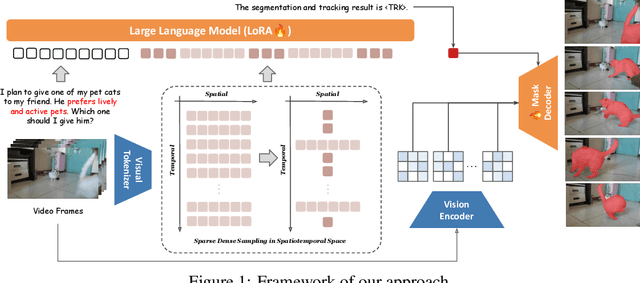
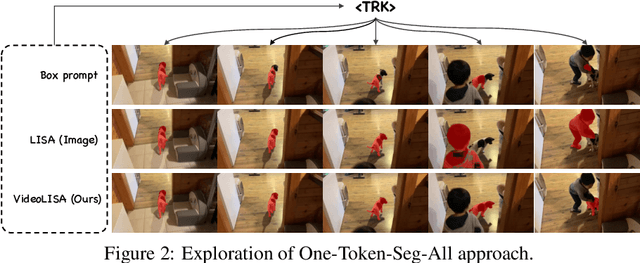

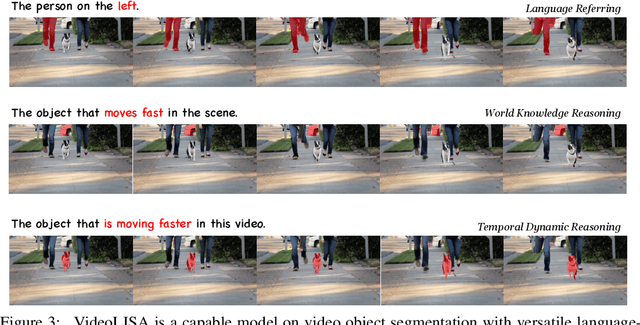
Abstract:We introduce VideoLISA, a video-based multimodal large language model designed to tackle the problem of language-instructed reasoning segmentation in videos. Leveraging the reasoning capabilities and world knowledge of large language models, and augmented by the Segment Anything Model, VideoLISA generates temporally consistent segmentation masks in videos based on language instructions. Existing image-based methods, such as LISA, struggle with video tasks due to the additional temporal dimension, which requires temporal dynamic understanding and consistent segmentation across frames. VideoLISA addresses these challenges by integrating a Sparse Dense Sampling strategy into the video-LLM, which balances temporal context and spatial detail within computational constraints. Additionally, we propose a One-Token-Seg-All approach using a specially designed <TRK> token, enabling the model to segment and track objects across multiple frames. Extensive evaluations on diverse benchmarks, including our newly introduced ReasonVOS benchmark, demonstrate VideoLISA's superior performance in video object segmentation tasks involving complex reasoning, temporal understanding, and object tracking. While optimized for videos, VideoLISA also shows promising generalization to image segmentation, revealing its potential as a unified foundation model for language-instructed object segmentation. Code and model will be available at: https://github.com/showlab/VideoLISA.
VideoLLM-MoD: Efficient Video-Language Streaming with Mixture-of-Depths Vision Computation
Aug 29, 2024



Abstract:A well-known dilemma in large vision-language models (e.g., GPT-4, LLaVA) is that while increasing the number of vision tokens generally enhances visual understanding, it also significantly raises memory and computational costs, especially in long-term, dense video frame streaming scenarios. Although learnable approaches like Q-Former and Perceiver Resampler have been developed to reduce the vision token burden, they overlook the context causally modeled by LLMs (i.e., key-value cache), potentially leading to missed visual cues when addressing user queries. In this paper, we introduce a novel approach to reduce vision compute by leveraging redundant vision tokens "skipping layers" rather than decreasing the number of vision tokens. Our method, VideoLLM-MoD, is inspired by mixture-of-depths LLMs and addresses the challenge of numerous vision tokens in long-term or streaming video. Specifically, for each transformer layer, we learn to skip the computation for a high proportion (e.g., 80\%) of vision tokens, passing them directly to the next layer. This approach significantly enhances model efficiency, achieving approximately \textasciitilde42\% time and \textasciitilde30\% memory savings for the entire training. Moreover, our method reduces the computation in the context and avoid decreasing the vision tokens, thus preserving or even improving performance compared to the vanilla model. We conduct extensive experiments to demonstrate the effectiveness of VideoLLM-MoD, showing its state-of-the-art results on multiple benchmarks, including narration, forecasting, and summarization tasks in COIN, Ego4D, and Ego-Exo4D datasets.
Learning Video Context as Interleaved Multimodal Sequences
Jul 31, 2024


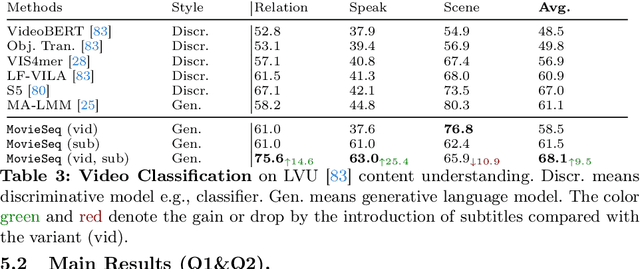
Abstract:Narrative videos, such as movies, pose significant challenges in video understanding due to their rich contexts (characters, dialogues, storylines) and diverse demands (identify who, relationship, and reason). In this paper, we introduce MovieSeq, a multimodal language model developed to address the wide range of challenges in understanding video contexts. Our core idea is to represent videos as interleaved multimodal sequences (including images, plots, videos, and subtitles), either by linking external knowledge databases or using offline models (such as whisper for subtitles). Through instruction-tuning, this approach empowers the language model to interact with videos using interleaved multimodal instructions. For example, instead of solely relying on video as input, we jointly provide character photos alongside their names and dialogues, allowing the model to associate these elements and generate more comprehensive responses. To demonstrate its effectiveness, we validate MovieSeq's performance on six datasets (LVU, MAD, Movienet, CMD, TVC, MovieQA) across five settings (video classification, audio description, video-text retrieval, video captioning, and video question-answering). The code will be public at https://github.com/showlab/MovieSeq.
VideoLLM-online: Online Video Large Language Model for Streaming Video
Jun 17, 2024
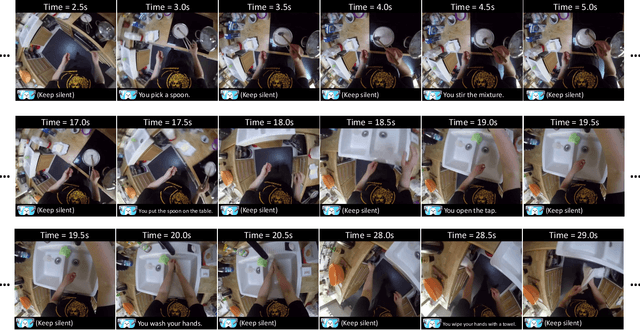

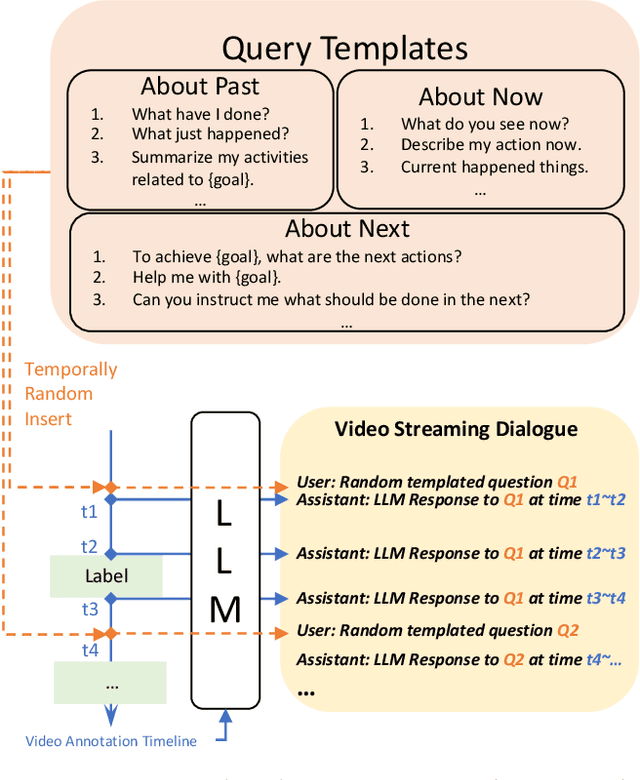
Abstract:Recent Large Language Models have been enhanced with vision capabilities, enabling them to comprehend images, videos, and interleaved vision-language content. However, the learning methods of these large multimodal models typically treat videos as predetermined clips, making them less effective and efficient at handling streaming video inputs. In this paper, we propose a novel Learning-In-Video-Stream (LIVE) framework, which enables temporally aligned, long-context, and real-time conversation within a continuous video stream. Our LIVE framework comprises comprehensive approaches to achieve video streaming dialogue, encompassing: (1) a training objective designed to perform language modeling for continuous streaming inputs, (2) a data generation scheme that converts offline temporal annotations into a streaming dialogue format, and (3) an optimized inference pipeline to speed up the model responses in real-world video streams. With our LIVE framework, we built VideoLLM-online model upon Llama-2/Llama-3 and demonstrate its significant advantages in processing streaming videos. For instance, on average, our model can support streaming dialogue in a 5-minute video clip at over 10 FPS on an A100 GPU. Moreover, it also showcases state-of-the-art performance on public offline video benchmarks, such as recognition, captioning, and forecasting. The code, model, data, and demo have been made available at https://showlab.github.io/videollm-online.
From a Social Cognitive Perspective: Context-aware Visual Social Relationship Recognition
Jun 12, 2024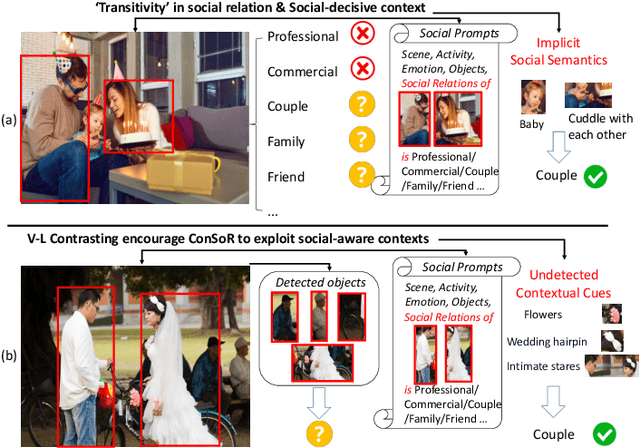



Abstract:People's social relationships are often manifested through their surroundings, with certain objects or interactions acting as symbols for specific relationships, e.g., wedding rings, roses, hugs, or holding hands. This brings unique challenges to recognizing social relationships, requiring understanding and capturing the essence of these contexts from visual appearances. However, current methods of social relationship understanding rely on the basic classification paradigm of detected persons and objects, which fails to understand the comprehensive context and often overlooks decisive social factors, especially subtle visual cues. To highlight the social-aware context and intricate details, we propose a novel approach that recognizes \textbf{Con}textual \textbf{So}cial \textbf{R}elationships (\textbf{ConSoR}) from a social cognitive perspective. Specifically, to incorporate social-aware semantics, we build a lightweight adapter upon the frozen CLIP to learn social concepts via our novel multi-modal side adapter tuning mechanism. Further, we construct social-aware descriptive language prompts (e.g., scene, activity, objects, emotions) with social relationships for each image, and then compel ConSoR to concentrate more intensively on the decisive visual social factors via visual-linguistic contrasting. Impressively, ConSoR outperforms previous methods with a 12.2\% gain on the People-in-Social-Context (PISC) dataset and a 9.8\% increase on the People-in-Photo-Album (PIPA) benchmark. Furthermore, we observe that ConSoR excels at finding critical visual evidence to reveal social relationships.
Bootstrapping SparseFormers from Vision Foundation Models
Dec 04, 2023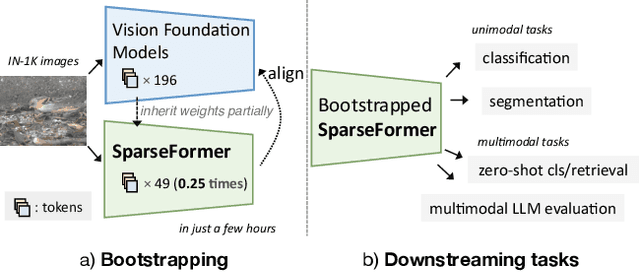

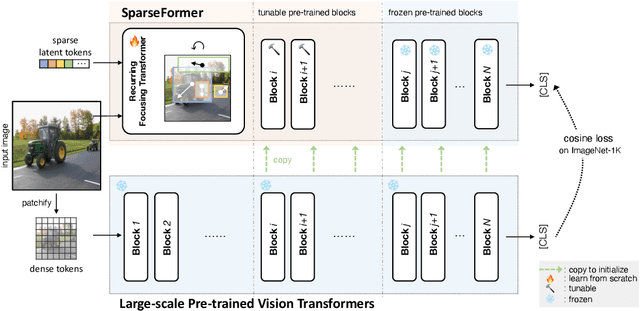
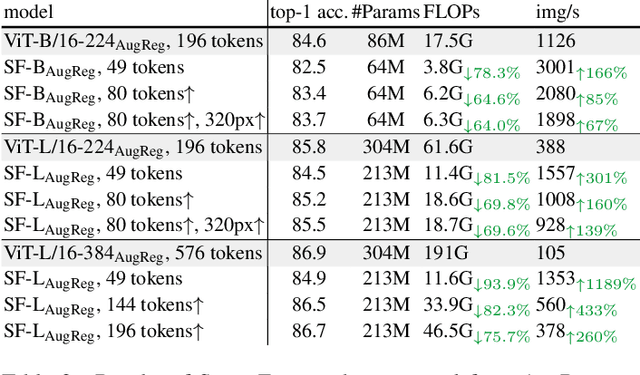
Abstract:The recently proposed SparseFormer architecture provides an alternative approach to visual understanding by utilizing a significantly lower number of visual tokens via adjusting RoIs, greatly reducing computational costs while still achieving promising performance. However, training SparseFormers from scratch is still expensive, and scaling up the number of parameters can be challenging. In this paper, we propose to bootstrap SparseFormers from ViT-based vision foundation models in a simple and efficient way. Since the majority of SparseFormer blocks are the standard transformer ones, we can inherit weights from large-scale pre-trained vision transformers and freeze them as much as possible. Therefore, we only need to train the SparseFormer-specific lightweight focusing transformer to adjust token RoIs and fine-tune a few early pre-trained blocks to align the final token representation. In such a way, we can bootstrap SparseFormer architectures from various large-scale pre-trained models (e.g., IN-21K pre-trained AugRegs or CLIPs) using a rather smaller amount of training samples (e.g., IN-1K) and without labels or captions within just a few hours. As a result, the bootstrapped unimodal SparseFormer (from AugReg-ViT-L/16-384) can reach 84.9% accuracy on IN-1K with only 49 tokens, and the multimodal SparseFormer from CLIPs also demonstrates notable zero-shot performance with highly reduced computational cost without seeing any caption during the bootstrapping procedure. In addition, CLIP-bootstrapped SparseFormers, which align the output space with language without seeing a word, can serve as efficient vision encoders in multimodal large language models. Code will be publicly available at https://github.com/showlab/sparseformer
Ego-Exo4D: Understanding Skilled Human Activity from First- and Third-Person Perspectives
Nov 30, 2023



Abstract:We present Ego-Exo4D, a diverse, large-scale multimodal multiview video dataset and benchmark challenge. Ego-Exo4D centers around simultaneously-captured egocentric and exocentric video of skilled human activities (e.g., sports, music, dance, bike repair). More than 800 participants from 13 cities worldwide performed these activities in 131 different natural scene contexts, yielding long-form captures from 1 to 42 minutes each and 1,422 hours of video combined. The multimodal nature of the dataset is unprecedented: the video is accompanied by multichannel audio, eye gaze, 3D point clouds, camera poses, IMU, and multiple paired language descriptions -- including a novel "expert commentary" done by coaches and teachers and tailored to the skilled-activity domain. To push the frontier of first-person video understanding of skilled human activity, we also present a suite of benchmark tasks and their annotations, including fine-grained activity understanding, proficiency estimation, cross-view translation, and 3D hand/body pose. All resources will be open sourced to fuel new research in the community.
UniVTG: Towards Unified Video-Language Temporal Grounding
Aug 18, 2023Abstract:Video Temporal Grounding (VTG), which aims to ground target clips from videos (such as consecutive intervals or disjoint shots) according to custom language queries (e.g., sentences or words), is key for video browsing on social media. Most methods in this direction develop taskspecific models that are trained with type-specific labels, such as moment retrieval (time interval) and highlight detection (worthiness curve), which limits their abilities to generalize to various VTG tasks and labels. In this paper, we propose to Unify the diverse VTG labels and tasks, dubbed UniVTG, along three directions: Firstly, we revisit a wide range of VTG labels and tasks and define a unified formulation. Based on this, we develop data annotation schemes to create scalable pseudo supervision. Secondly, we develop an effective and flexible grounding model capable of addressing each task and making full use of each label. Lastly, thanks to the unified framework, we are able to unlock temporal grounding pretraining from large-scale diverse labels and develop stronger grounding abilities e.g., zero-shot grounding. Extensive experiments on three tasks (moment retrieval, highlight detection and video summarization) across seven datasets (QVHighlights, Charades-STA, TACoS, Ego4D, YouTube Highlights, TVSum, and QFVS) demonstrate the effectiveness and flexibility of our proposed framework. The codes are available at https://github.com/showlab/UniVTG.
AssistGPT: A General Multi-modal Assistant that can Plan, Execute, Inspect, and Learn
Jun 28, 2023Abstract:Recent research on Large Language Models (LLMs) has led to remarkable advancements in general NLP AI assistants. Some studies have further explored the use of LLMs for planning and invoking models or APIs to address more general multi-modal user queries. Despite this progress, complex visual-based tasks still remain challenging due to the diverse nature of visual tasks. This diversity is reflected in two aspects: 1) Reasoning paths. For many real-life applications, it is hard to accurately decompose a query simply by examining the query itself. Planning based on the specific visual content and the results of each step is usually required. 2) Flexible inputs and intermediate results. Input forms could be flexible for in-the-wild cases, and involves not only a single image or video but a mixture of videos and images, e.g., a user-view image with some reference videos. Besides, a complex reasoning process will also generate diverse multimodal intermediate results, e.g., video narrations, segmented video clips, etc. To address such general cases, we propose a multi-modal AI assistant, AssistGPT, with an interleaved code and language reasoning approach called Plan, Execute, Inspect, and Learn (PEIL) to integrate LLMs with various tools. Specifically, the Planner is capable of using natural language to plan which tool in Executor should do next based on the current reasoning progress. Inspector is an efficient memory manager to assist the Planner to feed proper visual information into a specific tool. Finally, since the entire reasoning process is complex and flexible, a Learner is designed to enable the model to autonomously explore and discover the optimal solution. We conducted experiments on A-OKVQA and NExT-QA benchmarks, achieving state-of-the-art results. Moreover, showcases demonstrate the ability of our system to handle questions far more complex than those found in the benchmarks.
 Add to Chrome
Add to Chrome Add to Firefox
Add to Firefox Add to Edge
Add to Edge